| Universiti Putra Malaysia (Malay) | |
 Emblem of UPM Emblem of UPM | |
| Former names | School of Agriculture (1931–1947) College of Agriculture Malaya (1947–1971) Universiti Pertanian Malaysia (1971–1997) |
|---|---|
| Motto | Berilmu Berbakti |
| Motto in English | With Knowledge We Serve |
| Type | Public research university |
| Established | 29 October 1971; 53 years ago (1971-10-29) |
| Chancellor | Sultan Sharafuddin Idris Shah |
| Vice-Chancellor | Ahmad Farhan Mohd Sadullah |
| Academic staff | 1,759 (Dec 2022) |
| Administrative staff | 4,809 (Dec 2022) |
| Students | 29,060 (Dec 2022) |
| Undergraduates | 16,797 (Dec 2022) |
| Postgraduates | 12,263 (Dec 2022) |
| Address | Persiaran Universiti, Serdang, Selangor, 43400, Malaysia |
| Campus | Urban, 1,245.056 hectares (3,076.60 acres) |
| Colours | Red, grey and white |
| Affiliations | AAACU, ACU, APAARI, APUCEN, ASAIHL, ASEA-UNINET, AUAP, AUN, FUIW, UAiTED |
| Website | upm |
 | |
University of Putra Malaysia (Malay: Universiti Putra Malaysia), abbreviated as UPM, is a Malaysian public research university located in Serdang, Selangor. Formerly it was named Universiti Pertanian Malaysia (Agricultural University of Malaysia), focusing on agricultural sciences and related fields. Since the 1990s, the fields of study have expanded to include human ecology, languages, architecture, medicine, computer science and biotechnology. Currently there are 15 faculties, 11 institutes and 2 schools covering these as well as agriculture, forestry, veterinary medicine, economics, engineering, sciences, and education.
UPM has been recognised as a research university since 2006, one of five present in Malaysia. In 2010, self-accreditation status was awarded by Malaysian Qualifications Agency to simplify the procedure of accrediting academic programs, strengthening its own Internal Quality Assurance (IQA) system to compete among local universities.
History

On 21 May 1931, UPM was established as School of Agriculture, located on Serdang with 22 acres (9 hectares) of land. The only two programmes offered were a three-year diploma programme and a one-year certificate course in agriculture. On 23 June 1947, the school was upgraded to the College of Agriculture Malaya, as declared by the then Governor of Malayan Union, Sir Edward Gent.
On 29 October 1971, Universiti Pertanian Malaysia (literally Agricultural University of Malaysia) was officially established through the merger of College of Agriculture Malaya and the Faculty of Agriculture, University of Malaya. UPM began with three faculties in the fields of agriculture, forestry and veterinary medicine. On 23 July 1973, UPM had its first academic session with intake of 1,559 students. On 30 July 1977, UPM held the first convocation ceremony, which also declared the appointment of UPM's first Chancellor, Sultan Salahuddin Abdul Aziz Shah.
On 3 April 1997, UPM changed its name to Universiti Putra Malaysia, declared by Mahathir Mohamad, the then Prime Minister of Malaysia. The reason for changing name was to indicate UPM's diversification of the fields of study it offered, especially in Science and Technology. The word "Putra" is taken from Tunku Abdul Rahman Putra Al-Haj, the first Prime Minister of Malaysia. One of the reasons the word "Putra" was chosen is because the location of UPM near to Putrajaya. To correspond with the new name, UPM changed the logo as well.
List of chancellors and vice-chancellors
| # | Chancellors | Term in office |
|---|---|---|
| 1 | Sultan Salahuddin of Selangor | 1 January 1977 – 30 July 1993 |
| 2 | Hamdan Sheikh Tahir the Governor of Penang | 1 August 1993 – 31 March 2002 |
| 3 | Sultan Sharafuddin of Selangor | 1 April 2002 – Incumbent |
| # | Vice-Chancellors | Academic qualification | Term in office |
|---|---|---|---|
| 1 | Mohd Rashdan Baba | Diploma of Agriculture (College of Agriculture Malaya), Bachelor of Agricultural Science (Reading), PhD in Agricultural Science (Leeds). | 4 November 1971 – 28 February 1982 |
| 2 | Nayan Ariffin | Diploma in Agriculture (College of Agriculture Malaya), Bachelor of Agricultural Science (Louisiana), Master of Education in Advanced Science (Louisiana), PhD in Extension Education (Wisconsin). | 1 March 1982 – 4 June 1994 |
| 3 | Syed Jalaludin Syed Salim | Bachelor of Veterinary Science (Punjab), Master in Animal Science (London), PhD in Animal Science (London). | 5 June 1994 – 17 April 2001 |
| 4 | Muhammad Zohadie Bardaie | Diploma of Agriculture (UPM), Bachelor of Science in engineering (California), Master of Engineering (California), PhD of Agricultural Engineering (Cornell). | 18 April 2001 – 31 December 2005 |
| 5 | Nik Mustapha Raja Abdullah | Diploma of Agriculture (UPM), Bachelor of Economics (California), Master of Agricultural Science (Oregon), PhD of economics (Oregon). | 1 January 2006 – 31 December 2010 |
| 6 | Radin Umar Radin Sohadi | Bachelor of Civil Engineering (UPM), Master of Engineering (Sheffield), PhD of engineering (Birmingham). | 1 January 2011 – 31 December 2012 |
| 7 | Mohd Fauzi Ramlan | Diploma of Agriculture (UPM), Bachelor of Science in agronomy (Iowa), Master of Science (Louisiana), PhD in biology (York). | 1 January 2013 – 31 December 2015 |
| 8 | Aini Ideris | Bachelor of Veterinary Medication (UPM), Master of Veterinary Science (Liverpool), PhD in Veterinary Science (UPM). | 1 January 2016 – 31 August 2020 |
| 9 | Roslan Sulaiman | Bachelor of Veterinary Medication (UPM), PhD in Nervous System Physiology (Edinburgh). | 1 September 2020 – 31 August 2023 |
| 10 | Ahmad Farhan Mohd Sadullah | Bachelor of Civil Engineering (CUA), Master of Transportation (Imperial), PhD in Transportation Studies (UCL). | 2 October 2023 – Incumbent |
Campus
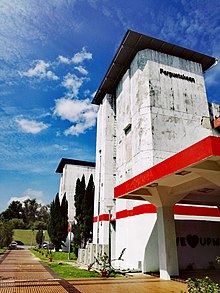
Aside from the main campus in Serdang, UPM has a branch campus in Bintulu, Sarawak. In June 1987, the National Resources Training Centre relocated to Bintulu from its provisional campus in Kuching. On 27 August 1987, the campus in Bintulu became a branch campus of UPM, abbreviated as UPMKB. Currently the Bintulu campus consists of 2 faculties, the Faculty of Agricultural and Forestry Sciences and the Faculty of Humanities, Management and Science, as well as one institute, the Institute of Ecosystem Science Borneo. The campus offers undergraduate and postgraduate programmes, with approximately 1600 students in total.
UPM used to have another branch campus in Mengabang Telipot, Kuala Terengganu from 1996 until the establishment of Terengganu University College in 1999. Originally, it was the Centre for Fisheries and Marine Science under UPM. In June 1996, the UPM's Faculty of Fisheries and Marine Science was transferred to Kuala Terengganu it was made into a branch campus of UPM. Starting from 5 May 1999, it was named Terengganu University College and became an associate campus of UPM. In 2001, it was given autonomy and renamed again as Malaysian Science and Technology University College. It has been upgraded to university status in 2007, as the Universiti Malaysia Terengganu.
Academic profile
UPM began its academic life in 1973 with three founding Faculties and a Division of Basic Sciences. The first intake of 1,559 students was for bachelor's degrees in Agricultural Science or Forestry Science, Doctor of Veterinary Medicine, Diploma in Home Technology, Diploma in Animal Health and Production, Diploma in Science with Education, and Preliminary Programme. As of 2021, UPM has 15 faculties, 11 institutes and 2 schools, offers 8 diploma programmes, 80 bachelor programmes, 66 Masters programmes by coursework and more than 300 fields of study in Master and Doctoral programmes by research. The Doctor of Medicine program provided by the Medical and Health Science division of the university was fully recognised by the Malaysia Medical Council on 5 June 2001. The School of Business and Economics (previously Faculty of Economics and Management) has received AACSB and EQUIS accreditation in 2012 and 2022 respectively.
Faculties, schools and institutes
As of February 2024, UPM has 15 faculties, 11 institutes and 2 schools.
-
Faculty of Agriculture
-
 Faculty of Forestry and Environment
Faculty of Forestry and Environment
-
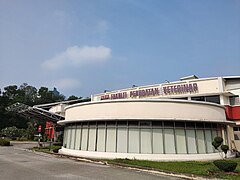 Faculty of Veterinary Medicine
Faculty of Veterinary Medicine
-
 School of Business and Economics
School of Business and Economics
-
 Faculty of Engineering
Faculty of Engineering
-
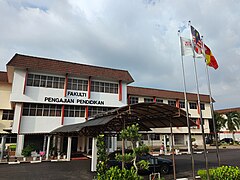 Faculty of Educational Studies
Faculty of Educational Studies
-
 Faculty of Science
Faculty of Science
-
 Faculty of Food Science and Technology
Faculty of Food Science and Technology
-
 Faculty of Human Ecology
Faculty of Human Ecology
-
 Faculty of Modern Languages and Communication
Faculty of Modern Languages and Communication
-
 Faculty of Design and Architecture
Faculty of Design and Architecture
-
 Faculty of Medicine and Health Sciences
Faculty of Medicine and Health Sciences
-
 Faculty of Computer Science and Information Technology
Faculty of Computer Science and Information Technology
-
 Faculty of Biotechnology and Biomolecular Sciences
Faculty of Biotechnology and Biomolecular Sciences
-
 Faculty of Agricultural and Forestry Sciences & Faculty of Humanities, Management and Science
Faculty of Agricultural and Forestry Sciences & Faculty of Humanities, Management and Science
-
 School of Graduate Studies
School of Graduate Studies
-
 Institute of Bioscience
Institute of Bioscience
-
 Institute of Nanoscience and Nanotechnology
Institute of Nanoscience and Nanotechnology
-
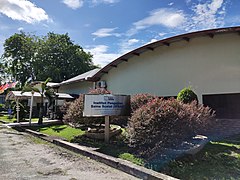 Institute for Social Science Studies
Institute for Social Science Studies
-
 Malaysian Research Institute on Ageing
Malaysian Research Institute on Ageing
-
 Institute for Mathematical Research
Institute for Mathematical Research
-
 Halal Products Research Institute
Halal Products Research Institute
-
 Institute of Tropical Forestry and Forest Products
Institute of Tropical Forestry and Forest Products
-
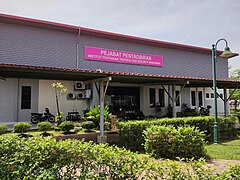 Institute of Tropical Agriculture and Food Security
Institute of Tropical Agriculture and Food Security
-
 Institute of Plantation Studies
Institute of Plantation Studies
Campus life
Residential colleges

The accommodation units in UPM are called "colleges", however, the colleges are not related to education, but built to provide accommodation for students, known as "residential college" or kolej kediaman. Before the UPM's Governance Transformation Plan, there were 17 residential colleges in Serdang campus and one in Bintulu campus. The residential colleges in Serdang campus can be divided into four zone, which are lembah, pinggiran, bukit and serumpun.
The Mohamad Rashid College (KMR) is the oldest residential college in UPM, it was once named as Kolej Kediaman Pertama. After it was renovated, it has been transformed into KMR OnePUTRA Residence and managed by UPM Holdings since 2019.
The Tenth College (K10) and the Tan Sri Mustaffa Babjee College (KMB) are two colleges at zon pinggiran because they are distant from other colleges, located at northeast and southwest of UPM respectively. K10 accommodate the students from Faculty of Engineering and Faculty of Design and Architecture while KMB accommodates the students from Faculty of Veterinary Medicine and Faculty of Medicine and Health Sciences.
The Twelfth College (K12) and Fourteenth College (K14) are located at zon serumpun and known as "Serumpun Colleges". They are built by PJS Development, a private construction company through the form of BOT. Currently, part of Serumpun zone is now included into Tan Sri Aishah Ghani College as KTAG zone B.
The Sri Rajang College (KSR) is the only residential college in Bintulu campus, consists of 10 blocks that could accommodate up to 1,560 students.
The Governance Transformation Plan in 2019 has restructured the residential colleges in Serdang campus. Most of them have been merged with another college to save costs and improve administrative efficiency. As of 2024, the list of residential colleges which are managed by UPM is as follow:
- Tun Dr. Ismail College (KTDI)
- Chancellor College (KC)
- Sultan Alaeddin Suleiman Shah College (KOSASS)
- Pendeta Za'ba College (KPZ)
- Tenth College (K10)
- Twelfth College (K12)
- Tan Sri Aishah Ghani College (KTAG)
- Fourteenth College (K14)
- Tan Sri Mustaffa Babjee College (KTMB)
- Sri Rajang College (KSR)
Libraries

UPM has one main library and three branch libraries in Serdang campus, and one library in Bintulu campus.
The Sultan Abdul Samad Library (Malay: Perpustakaan Sultan Abdul Samad, abbreviation: PSAS) is the main library of UPM. It existed before the establishment of UPM in 1971. The library was renamed the Sultan Abdul Samad Library and inaugurated on 23 May 2002, named after Sultan Abdul Samad, the fourth Sultan of Selangor. PSAS consists of block A and B (completed in 1982 and 1969 respectively), with total floor area of 19,007 square metres. The Anjung Siswazah located at block B is a space specially for postgraduate students, its collection are including printed materials, media and electronics.
Another three branch libraries in Serdang campus are Medicine and Health Sciences Library (1998), Veterinary Medicine Library (1999), and Engineering and Architecture Library (2008). The library in Bintulu start operating when the campus was reopened in 2001. The operating hour of each library might varying based on the academic period of semester.
Main hall
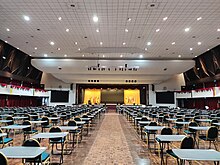
The Sultan Salahuddin Abdul Aziz Shah Arts and Cultural Centre (Malay: Pusat Kebudayaan dan Kesenian Sultan Salahuddin Abdul Aziz Shah, abbreviation: PKKSSAAS) is the main hall in Serdang campus. It was completed in 1978 and known as the Great Hall of UPM (Dewan Besar UPM) before its name was changed. On 25 April 1996, the hall was inaugurated by Sultan Salahuddin Abdul Aziz Shah, the eighth Sultan of Selangor. Since then, UPM renamed the Great Hall to its current name. PKKSSAAS is the venue for orientation, convocation, and even examinations.
The Experimental Theatre (Panggung Percubaan) is part of PKKSSAAS. It is a place for workshops on culture and arts, suitable for theatre performances and debate competition. It can also be used as a platform for the trial of performances.
Mosque
The UPM Mosque (Malay: Masjid UPM) is the university mosque that built to fulfill the prayer needs of Muslim community from UPM and Taman Sri Serdang. The construction started in 1987 and completed in 1989, with total area of 9 hectares. The exterior design of the mosque is inspired by Saladin's war helmet, symbolising the spirit of Jihad in Islam. The mosque consists of 2 floors, able to congregate 9,500 people at the same time. The University Islamic Centre, founded on 1 October 1988, is responsible for managing the mosque and Islamic affairs of UPM.
Expo Hill
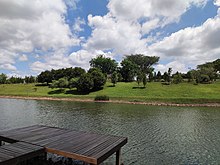
The Expo Hill (Malay: Bukit Ekspo) is a recreational place in UPM, located at south of Thirteenth College and northwest of UniPutra Golf Club. With the area approximately 12 hectares, it has divided into five zones. Another 13 hectares is made up of 5 freshwater fish ponds which are rearing 5 different fish species (Lampam, Tilapia, Rohu, Belida and Sepat). The Expo Hill was used as the venue of the Agricultural Expo and Convocation Festival for the first time during the first convocation of UPM in 1977. There is an elevated railway track crossing the Expo Hill, travelled by KLIA Ekspres and KLIA Transit, to which the nearest station is Bandar Tasik Selatan station.
Transportation accessibility
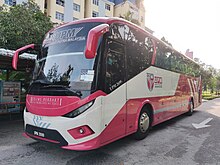
In Serdang campus, UPM buses travel between faculties and residential colleges to bring students to their destination. Starting from August 2023, UPM diminished the bus service to minimise carbon footprint and reduce expense. However, the MRT feeder buses with route number [REDACTED] T568 are alternative transportation for the public including the UPM students. Passenger shall pay RM 1.00 with Touch 'n Go card from any station to any station.
The MRT of 12 Putrajaya Line has been fully operational since 16 March 2023, the PY34 UPM MRT station is located at the northwest edge of UPM, adjacent to the Family, Adolescent and Child Research Centre of Excellence (FACE). Except the Trek Rides demand-responsive transport service powered by Selangor Mobility, the MRT station is also accessible by feeder buses which their frequency is between 20 minutes and 1 hour, depends on the expected peak hours.
Although e-hailing is available in campus, students could getting to downtown by [REDACTED] SJ04 Smart Selangor bus. The stations are including South City Plaza, The Mines, PY33 Serdang Jaya MRT station and the KB05 Serdang KTM station as the terminus.
Rankings
| University rankings | |
|---|---|
| Global – Overall | |
| ARWU World | 601-700 |
| CWTS World | 321 |
| QS World | 148 |
| RUR World | 139 |
| THE World | 601-800 |
| USNWR Global | 544 |
| Regional – Overall | |
| QS Asia | 20 |
| THE Asia | 102 |
| THE Emerging Economies | 81 |
| National – Overall | |
| QS National | 4 |
| THE National | 8 |
The graphs below show the QS Rankings and THE Rankings respectively. The rankings by region (Asia) are not same as the Asian universities' ranking filtered from world rankings because QS changed the indicators and weightings; THE also recalibrated their results to reflect priorities and attributes of Asian universities. In the 2021 rankings, QS Top 50 Under 50 and THE Young University Ranking ranked UPM for the last time because 50 years had passed since it was established as a university in 1971.
| Graphs are unavailable due to technical issues. Updates on reimplementing the Graph extension, which will be known as the Chart extension, can be found on Phabricator and on MediaWiki.org. |
| Graphs are unavailable due to technical issues. Updates on reimplementing the Graph extension, which will be known as the Chart extension, can be found on Phabricator and on MediaWiki.org. |
THE Impact rankings
Times Higher Education Impact Rankings are the global performance tables that assess universities against the United Nations' Sustainable Development Goals (SDGs).
| Year | Rank |
|---|---|
| 2019 | 201-300 |
| 2020 | 101-200 |
| 2021 | 201-300 |
| 2022 | 201-300 |
| 2023 | 201-300 |
| 2024 | 401-600 |
UI GreenMetric

In 2024, Universiti Putra Malaysia is ranked 24th in the world. The ranking of UI GreenMetric is based on six criteria:
- Setting & infrastructure (15%)
- Energy & climate change (21%)
- Waste (18%)
- Water (10%)
- Transportation (18%)
- Education & research (18%)
| Year | Overall rankings | Total score |
|---|---|---|
| 2010 | 6 | 7698.60 |
| 2011 | 17 | 7204.60 |
| 2012 | 19 | 6570.03 |
| 2013 | 16 | 6672.85 |
| 2014 | 42 | 6628 |
| 2015 | 17 | 6491 |
| 2016 | 34 | 6543 |
| 2017 | 27 | 6420 |
| 2018 | 32 | 7575 |
| 2019 | 28 | 8000 |
| 2020 | 28 | 8125 |
| 2021 | 27 | 8425 |
| 2022 | 25 | 8800 |
| 2023 | 25 | 8900 |
| 2024 | 24 | 9050 |
Notable academics
- Dato' Abu Bakar Salleh, Enzyme and microbial technology scientist, Former Deputy Vice-Chancellor Research and Innovation
- Chin Hoong Fong, Seed scientist, Professor Emeritus
- Mohd Sapuan Salit, Material scientist and engineer
- Tan Sri Omar Abdul Rahman (academic), Veterinary scientist, Former Deputy Vice-Chancellor Academic Affairs
- Willie Soon, Astrophysicist and aerospace engineer
- First Admiral (Retired) Sutarji Kasmin, Former navy special forces commander.
- Datin Paduka Khatijah Yusoff, Virologist
- Ahmad Zaharin Aris, Professor of hydrochemistry
Notable alumni
See also: Category:University of Putra Malaysia alumniPoliticians
- Dato' Seri Dr. Ahmad Zahid Hamidi, Deputy Prime Minister of Malaysia
- Datuk Seri Saifuddin Nasution Ismail, Minister of Home Affairs
- Chang Lih Kang, Minister of Science, Technology and Innovation
- Dato' Seri Amirudin Shari, Menteri Besar of Selangor
- Tan Kar Hing, Member of Parliament (MP) for Gopeng
- Penguang Manggil, State Deputy Minister of Public Health and Housing of Sarawak
- Najwan Halimi, Member of the Selangor State Executive Council (EXCO)
- Wong Siew Ki, Member of the Selangor State Legislative Assembly (MLA) for Seri Kembangan
- Datuk Seri Ronald Kiandee, former Minister of Agriculture and Food Industries
- Datuk Seri Haji Salahuddin Ayub, former Minister of Domestic Trade and Living Costs
- Dato' Sri Hajah Rohani Abdul Karim, former Minister of Women, Family and Community Development
- Datuk Seri Dr Mujahid Yusof Rawa, former Minister in the Prime Minister's Department (Religious Affairs)
- Datuk Seri Wilfred Madius Tangau, former Deputy Chief Minister of Sabah
- Chong Eng, former MP for Bukit Mertajam
- Irwan Prayitno, 9th Governor of West Sumatra, Indonesia
Athletes
|
Academics
Businesspeople
Civil servants
Poets
|
See also
- Universiti Putra Malaysia Bintulu Campus
- List of universities in Malaysia
- UPM Press
- Malay Heritage Museum
Notes
- The School of Agriculture was established on 21 May 1931, and it became a university in 1971.
- The area of Serdang campus only.
- As Roslan's contract ended, the position remained vacant until his succeeder took over a month later.
References
- ^ "Facts & Figures". Universiti Putra Malaysia. Retrieved 5 March 2023.
- "Facts & Figures". Official portal of UPM. Archived from the original on 5 October 2022. Retrieved 5 October 2022.
- "ASEAN-European Academic University Network". Retrieved 22 August 2022.
- "Association of Universities of Asia and the Pacific".
- "Federation of the Universities of the Islamic World". Retrieved 22 August 2022.
- Sheriff, Nooraini Mohamad; Abdullah, Noordini (December 2017). "Research Universities in Malaysia: What Beholds?". Asian Journal of University Education. 13 (2). UiTM Press: 35–50. Retrieved 22 August 2022.
- "List of HEP (Self-Accredited)". MQA. Retrieved 22 August 2022.
- "Frequently Asked Questions (FAQs)". MQA. Retrieved 22 August 2022.
- Federation of Malaya: Annual Report 1946 (Report). The Stationery Office. p. 58. Retrieved 27 November 2024.
- "The Story Behind UPM". Portal UPM. Archived from the original on 14 August 2021. Retrieved 15 August 2021.
- Malaysia Official Year Book 1972 (Report). Jabatan Penerangan Malaysia. p. 420. Retrieved 27 November 2024.
- "Majlis Konvokesyen yang pertama". Universiti Putra Malaysia. Archived from the original on 26 February 2022. Retrieved 15 August 2021 – via Facebook.
- "Pengisytiharan nama baharu". Universiti Putra Malaysia. Archived from the original on 26 February 2022. Retrieved 15 August 2021 – via Facebook.
- "Previous UPM Chancellors". Universiti Putra Malaysia. Retrieved 4 April 2020.
- "Previous UPM Vice-Chancellors". Universiti Putra Malaysia. Retrieved 14 August 2021.
- ^ "Statistic of UPMKB". UPMKB. Retrieved 22 August 2022.
- "History of Universiti Malaysia Terengganu". Portal UMT. Retrieved 14 August 2021.
- "Facts & Figures 2021" (PDF). Portal UPM. Centre for Corporate Strategy and Relations (PSPK) UPM. Retrieved 15 August 2021.
- "List of Medical Institutions (Second Schedule Medical Act 1971)". Malaysian Medical Council. Retrieved 23 August 2022.
- "Universiti Putra Malaysia". AACSB. Retrieved 25 August 2022.
- "EQUIS Accredited Schools". EFMD Global. Retrieved 15 November 2022.
- ^ Ab Aziz, Sidek; Ahmad, Khairulmazmi; Hang Tuah Baharudin, B.T.; Mohd Moklas, Mohamad Aris; Sailful Yazan, Latifah; Alias, Mohamad Azani. "Pelaksanaan Kolej-Kolej Kembar di UPM: Isu dan Cabaran" (PDF). Majlis Perumahan Universiti Awam Malaysia (MAPUM). Retrieved 23 August 2021.
- "COLLEGE INTRODUCTION". Portal K14. Retrieved 29 August 2022.
- "LATAR BELAKANG KOSASS". Portal KOSASS. Archived from the original on 4 November 2020. Retrieved 4 November 2020.
- "About Library". Portal PSAS. Retrieved 24 August 2021.
- "Perpustakaan Sultan Abdul Samad". Universiti Putra Malaysia. Archived from the original on 26 February 2022. Retrieved 25 August 2021 – via Facebook.
- "Library Guide". Portal PSAS. Retrieved 7 April 2023.
- "Background". Portal PKKSSAAS. Retrieved 25 August 2021.
- "Pusat Kebudayaan dan Kesenian Sultan Salahuddin Abdul Aziz Shah". Universiti Putra Malaysia. Archived from the original on 26 February 2022. Retrieved 25 August 2021 – via Facebook.
- "Great Hall and Experimental Theatre". Portal PKKSSAAS. Retrieved 25 August 2021.
- "Masjid UPM". University Islamic Centre. Retrieved 2 September 2022.
- "Universiti Putra Malaysia". Academic Ranking of World Universities. Retrieved 13 October 2024.
- "CWTS Leiden Ranking 2024 (Scientific impact)". CWTS Leiden Ranking. Retrieved 13 October 2024.
- ^ "Universiti Putra Malaysia (UPM)". Retrieved 5 June 2024.
- "Universiti Putra Malaysia". Round University Ranking. Retrieved 13 October 2024.
- ^ "Universiti Putra Malaysia". Retrieved 13 October 2024.
- "Universiti Putra Malaysia". U.S. News & World Report. Retrieved 13 October 2024.
- "Emerging Economies University Rankings 2022". THE World University Rankings. 3 March 2021. Retrieved 26 August 2022.
- "Impact Rankings 2019". THE World University Rankings. 2 April 2019. Retrieved 18 September 2020.
- "Impact Rankings 2020". THE World University Rankings. 4 March 2020. Retrieved 18 September 2020.
- "Impact Rankings 2021". THE World University Rankings. 16 April 2021. Retrieved 27 May 2021.
- "Impact Rankings 2022". THE World University Rankings. 3 June 2022. Retrieved 3 June 2022.
- "Impact Rankings 2023". Times Higher Education (THE). 9 November 2023. Retrieved 9 November 2023.
- "Impact Rankings 2024". Times Higher Education (THE). 18 June 2024. Retrieved 18 June 2024.
- "Overall Rankings 2010". UI GreenMetric. Retrieved 10 June 2020.
- "Overall Rankings 2011". UI GreenMetric. Retrieved 10 June 2020.
- "Overall Rankings 2012". UI GreenMetric. Retrieved 10 June 2020.
- "Overall Rankings 2013". UI GreenMetric. Retrieved 10 June 2020.
- "Overall Rankings 2014". UI GreenMetric. Retrieved 10 June 2020.
- "Overall Rankings 2015". UI GreenMetric. Retrieved 10 June 2020.
- "Overall Rankings 2016". UI GreenMetric. Retrieved 10 June 2020.
- "Overall Rankings 2017". UI GreenMetric. Retrieved 10 June 2020.
- "Overall Rankings 2018". UI GreenMetric. Retrieved 10 June 2020.
- "Overall Rankings 2019". UI GreenMetric. Retrieved 10 June 2020.
- "Overall Rankings 2020". UI GreenMetric. Retrieved 9 November 2020.
- "Overall Rankings 2021". UI GreenMetric. Retrieved 21 December 2021.
- "Overall Rankings 2022". UI GreenMetric. Retrieved 14 December 2022.
- "Overall Rankings 2023". UI GreenMetric. Retrieved 14 December 2023.
- "Overall Rankings 2024". UI GreenMetric. Retrieved 14 December 2024.
- "Three national wushu athletes graduated with Masters". Universiti Putra Malaysia. Retrieved 23 March 2020.
External links
| ASEAN University Network | |
|---|---|
| Brunei | |
| Cambodia | |
| Indonesia |
|
| Laos |
|
| Malaysia |
|
| Myanmar |
|
| Philippines |
|
| Singapore | |
| Thailand |
|
| Vietnam |
|
| University Alliance in Talent Education Development | |
|---|---|
| Singapore | |
| Malaysia | |
| Hong Kong | |
| Taiwan | |
| Association of Southeast Asian Institutions of Higher Learning | |||||||||||||||||||
|---|---|---|---|---|---|---|---|---|---|---|---|---|---|---|---|---|---|---|---|
| Southeast Asia |
| ||||||||||||||||||
| East Asia |
| ||||||||||||||||||
| South Asia |
| ||||||||||||||||||
| Oceania |
| ||||||||||||||||||
| Europe |
| ||||||||||||||||||
| North America |
| ||||||||||||||||||
2°59′57″N 101°42′28″E / 2.99917°N 101.70778°E / 2.99917; 101.70778
Categories:- University of Putra Malaysia
- Universities and colleges established in 1931
- Agricultural universities and colleges in Malaysia
- Veterinary schools in Malaysia
- Business schools in Malaysia
- Engineering universities and colleges in Malaysia
- Design schools in Malaysia
- Medical schools in Malaysia
- Nursing schools in Malaysia
- Information technology schools in Malaysia
- ASEAN University Network